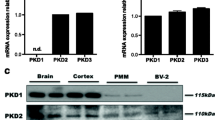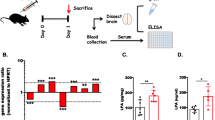Abstract
Our previous studies demonstrated the ability of proinflammatory cytokines, such as tumor necrosis factor-α (TNF-α) and interleukin 1β(IL-1β), to stimulate NFκB/DNA binding and synthesis of secretory phospholipase A2 (sPLA2) in immortalized astrocytes (DITNC). In this study, we examined possible involvement of lipid mediators in the cytokine action. Using [14C]serine to label sphingomyelin and ceramide in these cells, subsequent exposure of cells to cytokines did not result in alteration of sphingomyelin/ceramide ratio. Furthermore, neither exogenous sphingomyelinase nor cell-permeable ceramides could stimulate NFκB/DNA binding.
On the other hand, C-2 ceramide (0.3 µM) as well as other lipid mediators, such as lysophosphatidylcholine and arachidonic acid, were able to elicit a small increase in sPLA2 and potentiate the induction of sPLA2 by TNF-α. When DITNC cells were prelabeled with [32P]Pi, an increase in labeled phosphatidic acid (PA) was observed on treatment of cells with IL-1β (200 U/mL). However, despite the ability of phorbol myristate acetate (PMA) to stimulate phospholipase D (PLD) and synthesis of phosphatidylethanol (PEt) in these cells, PLD activity was not affected by Il-1β. With the [32P]labeled cells, however, PA-phosphohydrolase inhibitors, such as chlorpromazine and propranolol, could elicit large increases in labeled PA, indicating active PA metabolism in these cells. Cytokines also caused an increase in levels of diacylglycerol (DG) in these cells, although the source of this lipid pool is presently not understood. Taken together, these results provide evidence for the participation of PA and DG in cytokine signaling activity. Furthermore, although cytokines did not cause the release of ceramide, lipid mediators, such as lysophospholipids, and AA could modulate cytokine-mediated induction of sPLA2 in astrocytes.
Similar content being viewed by others
Abbreviations
- PA:
-
Phosphatidic acid
- PC:
-
phosphatidylcholine
- PE:
-
phosphatidylethanolamine
- PS:
-
phosphatidylserine
- AA:
-
arachidonic acid
- DG:
-
diacylglycerol
References
Abraham E., Bursten S., Shenkar R., Allbee J., Tuder R., Woodson P., et al. (1995) Phosphatidic acid signaling mediates lung cytokine expression and lung inflammatory injury after hemorrhage in mice.J. Exp. Med. 181, 569–575.
Aggarwal B. B. and Higuchi M. (1997) Role of ceramide in tumour necrosis factor-mediated apoptosis and nuclear factor-kappa B activation.Biochem. Soc. Trans. 25, 1166–1171.
Benveniste E. N. (1992) Inflammatory cytokines within the central nervous system: sources, function, and mechanism of action.Am. J. Physiol. 263, C1-C16.
Benveniste E. N. and Benos D. J. (1995) TNFα and IFN-γ-mediated signal transduction pathways: effects on glial cell gene expression and function.FASEB J. 9, 1577–1584.
Betts J. C., Agranoff A. B., Nabel G. J., and Shayman J. A. (1994) Dissociation of endogenous cellular ceramide from NF-κB activation.J. Biol. Chem. 269, 8455–8458.
Bursten S. L., Harris W. E., Bomsztyk K., and Lovett D. (1991) Interleukin-1 rapidly stimulates lysophosphatidate acyltransferase and phosphatidate phosphohydrolase activities in human mesangial cells.J. Biol. Chem. 266, 20,732–20,743.
Dbaibo G. S., Obeid L. M., and Hannun Y. A. (1993) Tumor necrosis factor-α (TNF-α) signal transduction through ceramide. Dissociation of growth inhibitory effects of TNF-α from activation of nuclear factor-κB.J. Biol. Chem. 268, 17,762–17,766.
Desagher S., Cordier J., Glowinski J., and Tence M. (1997) Endothelin stimulates phospholipase D in striatal astrocytes.J. Neurochem. 68, 78–87.
Dhalla N. S., Xu Y. J., Sheu S. S., Tappia P. S., and Panagia V. (1997) Phosphatidic acid: a potential signal transducer for cardiac hypertrophy.J. Mol. Cell. Cardiol. 29, 2865–2871.
Diehl J. A., Tong W., Sun G. Y., and Hannink M. (1995) Tumor necrosis factor-a-dependent activation of a RelA homodimer in astrocytes. Increased phosphorylation of RelA and MAD-3 precede activation of RelA.J. Biol. Chem. 270, 2703–2707.
Fukami K. and Takenawa T. (1992) Phosphatidic acid that accumulates in platelet-derived growth factor-stimulated Balb/c3T3 cells is a potential mitogenic signal.J. Biol. Chem. 267, 10,988–10,993.
Gomez-Munoz A. (1998) Modulation of cell signalling by ceramides.Biochim. Biophys. Acta 1391, 92–109.
Goto K., Watanabe M., Kondo H., Yuasa H., Sakane F., and Kanoh H. (1992) Gene cloning, sequence, expression and in situ localization of 80 kDa diacylglycerol kinase specific to oligodendrocyte of rat brain.Mol. Brain Res. 16, 75–87.
Gustavsson L., Lundqvist C., and Hansson E. (1993) Receptor-mediated phospholipase Dactivity in primary astroglial cultures.GLIA 8, 249–255.
Hannun Y. A. (1994) The sphingomyelin cycle and the second messenger function of ceramide.J. Biol. Chem. 269, 3125–3128.
Johns L. D., Sarr T., and Ranges G. E. (1994) Inhibition of ceramide pathway does not affect ability of TNF-α to activate nuclear factor-κB.J. Immunol. 152, 5877–5882.
Kelleher J. A. and Sun G. Y. (1989) Effects of free fatty acids and acyl-CoA on diacylglycerol kinase in rat brain.J. Neurosci. Res. 23, 87–94.
Kolesnick R., and Golde D. W. (1994) The sphingomyelin pathway in tumor necrosis factor and interleukin-1 signaling.Cell 77, 325–328.
Lang D., Malviya A. N., Hubsch A., Kanfer J. N., and Freysz L. (1995) Phosphatidic acid activation of protein kinase C in LA-N-1 neuroblastoma cells.Neurosci. Lett. 201, 199–202.
Lassegue B., Alexander R. W., Clark M., Akers M., and Griendling K. K. (1993) Phosphatidylcholine is a major source of phosphatidic acid and diacylglycerol in angiotensin II-stimulated vascular smooth-muscle cells.Biochem. J. 292, 509–517.
Lester M., Simonson M. S., Mene P., and Sedor J. R. (1989) Interleukin-1 generates transmembrane signals from phospholipids through novel pathways in cultured rat mesangial cells.J. Clin. Invest. 83, 718–723.
Limatola C., Schaap D., Moolenaar W. H., and van Blitterswijk W. J. (1994) Phosphatidic acid activation of protein kinase C-zeta overexpressed in COS cells: comparison with other protein kinase C isotypes and other acidic lipids.Biochem. J. 304, 1001–1008.
Mangoura D. and Dawson G. (1998) Programmed cell death in cortical chick embryo astrocytes is associated with activation of protein kinase PK60 and ceramide formation.J. Neurochem. 70, 130–138.
Murakami M., Nakatani Y., Atsumi G., Inoue K., and Kudo I. (1997) Regulatory functions of phospholipase A2.Crit. Rev. Immunol. 17, 225–283.
Nishizuka Y. (1992) Intracellular signaling by hydrolysis of phospholipids and activation of protein kinase C.Science 258, 607–614.
Oka S. and Arita H. (1991) Inflammatory factors stimulate expression of group II phospholipase A2 in rat cultured astrocytes. Two distinct pathways of the gene expression.J. Biol. Chem. 266, 9956–9960.
Pahan K., Sheikh F. G., Khan M., Namboodiri A. M. S., and Singh I. (1998) Sphingomyelinase and ceramide stimulate the expression of inducible nitric oxide synthase in rat primary astrocytes.J. Biol. Chem. 273, 2591–2600.
Preiss J., Loomis C. R., Bishop W. R., Stein R., Niedel J. E., and Bell R. M. (1986) Quantitative measurement of sn-1,2-diacylglycerols present in platelets, hepatocytes, and ras- and sis-transformed normal rat kidney cells.J. Biol. Chem. 261, 8597–8600.
Radany E. H., Brenner M., Besnard F., Bigornia V., Bishop J. M., and Deschepper C. F. (1992) Directed establishment of rat brain cell lines with the phenotypic characteristics of type 1 astrocytes.Proc. Natl. Acad. Sci. USA 89, 6467–6471.
Sakane F., Yamada K., Imai S-I., and Kanoh H. (1991) Porcine 80 kDa diacylglycerol kinase is a calcium-binding and calcium/phospholipid-dependent enzyme and undergoes calcium-dependent translocation.J. Biol. Chem. 266, 7096–7100.
Schutze S., Potthoff K., Machleidt T., Berkovic D., Wiegmann K., and Kronke M. (1992) TNF activates NF-κB by phosphatidylcholine-specific phospholipase C-induced “acidic” sphingomyelin breakdown.Cell 71, 765–776.
Schutze S., Machleidt T., and Kronke M. (1994) The role of diacylglycerol and ceramide in tumor necrosis factor and interleukin-1 signal transduction.J. Leukocyte Biol. 56, 533–541.
Serhan C. N., Haeggstrom J. Z., and Leslie C. C. (1996) Lipid mediator networks in cell signaling: update and impact of cytokines.FASEB J. 10, 1147–1158.
Siddiqui R. A. and Yang Y. C. (1995) Interleukin-11 induces phosphatic acid formation and activates MAP kinase in mouse 3T3-L1 cells.Cell. Signalling 7, 247–259.
Sun G. Y. (1988) Preparation and analysis of acyl and alkenyl groups of glycerophospholipids from brain subcellular membranes, inNeuromethods: Lipids and Related Compounds, vol. 7 (Boulton, A. A., Baker, G. B., and Horrocks, L. A., eds.), Humana Press, Clifton, New Jersey, pp. 63–82.
Sun G. Y. and Lin T. N. (1989) Time course for labeling of brain membrane phosphoinositides and other phospholipids after intracerebral injection of [32P]ATP. Evaluation by an improved HPTLC procedure.Life Sci. 44, 689–696.
Tong W., Hu Z. Y., and Sun G. Y. (1995) Stimulation of group II phospholipase A2 mRNA expression and release in an immortalized astrocyte cell line (DITNC) by LPS, TNFα and IL-1β. Interactive effects.Mol. Chem. Neuropathol. 25, 1–17, 1995.
Yoshimura S., Banno Y., Nakashima S., Takenaka K., Sakai H., Nishimura Y., et al. (1998) Ceramide formation leads to caspase-3 activation during hypoxic PC12 cell death. Inhibitory effects of Bcl-2 on ceramide formation and caspase-3 activation.J. Biol. Chem. 273, 6912–6917.
Author information
Authors and Affiliations
Rights and permissions
About this article
Cite this article
Tong, W., Shah, D., Xu, J. et al. Involvement of lipid mediators on cytokine signaling and induction of secretory phospholipase A2 in immortalized astrocytes (DITNC). J Mol Neurosci 12, 89–99 (1999). https://doi.org/10.1007/BF02736923
Received:
Revised:
Accepted:
Issue Date:
DOI: https://doi.org/10.1007/BF02736923




